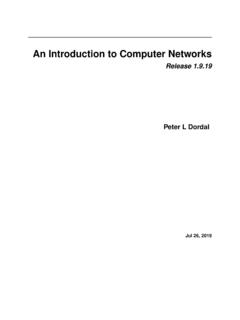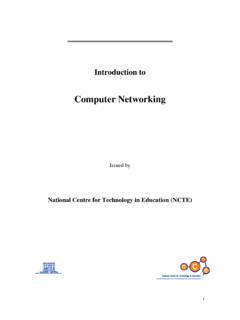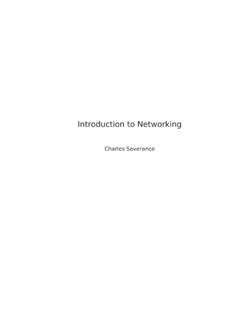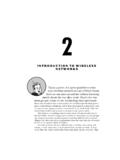Transcription of Senior Project Manager: Printer/Binder
1 James F. KuroseUniversity of Massachusetts, AmherstKeith W. RossPolytechnic Institute of NYUCOMPUTERNETWORKINGA Top-Down ApproachSIXTH EDITIONB oston Columbus Indianapolis New York San Francisco Upper Saddle RiverAmsterdamCape Town Dubai London Madrid Milan Munich Paris Montr al TorontoDelhi Mexico City S o Paulo Sydney Hong Kong Seoul Singapore Taipei TokyoVice President and Editorial Director, ECS:Marcia HortonEditor in Chief: Michael HirschEditorial Assistant:Emma SniderVice President Marketing:Patrice JonesMarketing Manager: Yez AlayanMarketing Coordinator: Kathryn FerrantiVice President and Director of Production: Vince O BrienManaging Editor: Jeff HolcombSenior Production Project Manager: Marilyn LloydManufacturing Manager: Nick SklitsisOperations Specialist: Lisa McDowellArt Director, Cover: Anthony GemmellaroArt Coordinator: Janet Theurer/Theurer Briggs DesignArt Studio.
2 Patrice Rossi Calkin/Rossi Illustration and DesignCover Designer: Liz Harasymcuk Text Designer: Joyce Cosentino WellsCover Image: Fancy/AlamyMedia Editor: Dan SandinFull-Service Vendor: PreMediaGlobalSenior Project Manager: Andrea StefanowiczPrinter/Binder:Edwards BrothersCover Printer: Lehigh-Phoenix ColorCopyright 2013, 2010, 2008, 2005, 2003 by Pearson Education, Inc., publishing asAddison-Wesley. All rights reserved. Manufactured in the United States of America. Thispublication is protected by Copyright, and permission should be obtained from the pub-lisher prior to any prohibited reproduction, storage in a retrieval system, or transmissionin any form or by any means, electronic, mechanical, photocopying, recording, or like-wise. To obtain permission(s) to use material from this work, please submit a writtenrequest to Pearson Education, Inc., Permissions Department, One Lake Street, UpperSaddle River, New Jersey 07458, or you may fax your request to of the designations by manufacturers and sellers to distinguish their products areclaimed as trademarks.
3 Where those designations appear in this book, and the publisher wasaware of a trademark claim, the designations have been printed in initial caps or all of Congress Cataloging-in-Publication DataKurose, James networking : a top-down approach / James F. Kurose, Keith W. Ross. 6th bibliographical references and : 978-0-13-285620-1 ISBN-10: 0-13-285620-41. Internet. 2. computer networks. I. Ross, Keith W., 1956- II. Title. dc23201104821510 9 8 7 6 5 4 3 2 1 ISBN-13: 978-0-13-285620-1 ISBN-10:0-13-285620-4 This book was composed in Quark. Basal font is Times. Display font is the AuthorsJim KuroseJim Kurose is a Distinguished University Professor of computer Science at theUniversity of Massachusetts, Kurose has received a number of recognitions for his educationalactivities including Outstanding Teacher Awards from the NationalTechnological University (eight times), the University of Massachusetts, andthe Northeast Association of Graduate Schools.
4 He received the IEEE TaylorBooth Education Medal and was recognized for his leadership ofMassachusetts Commonwealth Information Technology Initiative. He hasbeen the recipient of a GE Fellowship, an IBM Faculty Development Award,and a Lilly Teaching Kurose is a former Editor-in-Chief of IEEE Transactions onCommunicationsand of IEEE/ACM Transactions on hasbeen active in the program committees for IEEE Infocom, ACM SIGCOMM,ACM Internet Measurement Conference, and ACM SIGMETRICSfor anumber of years and has served as Technical Program Co-Chair for thoseconferences. He is a Fellow of the IEEE and the ACM. His research interestsinclude network protocols and architecture, network measurement, sensornetworks, multimedia communication, and modeling and performanceevaluation. He holds a PhD in computer Science from Columbia RossKeith Ross is the Leonard J. Shustek Chair Professor and Head of the ComputerScience Department at Polytechnic Institute of NYU.
5 Before joining NYU-Poly in2003, he was a professor at the University of Pennsylvania (13 years) and a professor at Eurecom Institute (5 years). He received a from TuftsUniversity, a from Columbia University, and a in computer andControl Engineering from The University of Michigan. Keith Ross is also thefounder and original CEO of Wimba, which develops online multimedia applications for e-learning and was acquired by Blackboard in Ross s research interests are in security and privacy, social networks,peer-to-peer networking , Internet measurement, video streaming, content distributionnetworks, and stochastic modeling. He is an IEEE Fellow, recipient of the Infocom2009 Best Paper Award, and recipient of 2011 and 2008 Best Paper Awardsfor Multimedia Communications (awarded by IEEE Communications Society). Hehas served on numerous journal editorial boards and conference program commit-tees, including IEEE/ACM Transactions on networking ,ACM SIGCOMM,ACMCoNext,and ACM Internet Measurement Conference.
6 He also has served as anadvisor to the Federal Trade Commission on P2P file page intentionally left blank To Julie and our three preciousones Chris, Charlie, and NinaJFKA big THANKS to my professors, colleagues, and students all over the page intentionally left blank PrefaceWelcome to the sixth edition of computer networking : A Top-Down Approach. Sincethe publication of the first edition 12 years ago, our book has been adopted for use atmany hundreds of colleges and universities, translated into 14 languages, and usedby over one hundred thousand students and practitioners worldwide. We ve heardfrom many of these readers and have been overwhelmed by the positive s New in the Sixth Edition?We think one important reason for this success has been that our book continues to offera fresh and timely approach to computer networking instruction. We ve made changesin this sixth edition, but we ve also kept unchanged what we believe (and the instruc-tors and students who have used our book have confirmed) to be the most importantaspects of this book: its top-down approach, its focus on the Internet and a moderntreatment of computer networking , its attention to both principles and practice, and itsaccessible style and approach toward learning about computer networking .
7 Neverthe-less, the sixth edition has been revised and updated substantially: The Companion Web site has been significantly expanded and enriched toinclude VideoNotes and interactive exercises, as discussed later in this Preface. In Chapter 1, the treatment of access networks has been modernized, and thedescription of the Internet ISP ecosystem has been substantially revised, account-ing for the recent emergence of content provider networks, such as Google s. Thepresentation of packet switching and circuit switching has also been reorganized,providing a more topical rather than historical orientation. In Chapter 2, Python has replaced Java for the presentation of socket program-ming. While still explicitly exposing the key ideas behind the socket API, Pythoncode is easier to understand for the novice programmer. Moreover, unlike Java,Python provides access to raw sockets, enabling students to build a larger varietyof network applications.
8 Java-based socket programming labs have beenreplaced with corresponding Python labs, and a new Python-based ICMP Pinglab has been added. As always, when material is retired from the book, such asJava-based socket programming material, it remains available on the book sCompanion Web site (see following text). In Chapter 3, the presentation of one of the reliable data transfer protocols hasbeen simplified and a new sidebar on TCP splitting, commonly used to optimizethe performance of cloud services, has been added. In Chapter 4, the section on router architectures has been significantly updated,reflecting recent developments and practices in the field. Several new integrativesidebars involving DNS, BGP, and OSPF are included. Chapter 5 has been reorganized and streamlined, accounting for the ubiquity ofswitched Ethernet in local area networks and the consequent increased use ofEthernet in point-to-point scenarios.
9 Also, a new section on data center network-ing has been added. Chapter 6 has been updated to reflect recent advances in wireless networks, par-ticularly cellular data networks and 4G services and architecture. Chapter 7, which focuses on multimedia networking , has gone through a majorrevision. The chapter now includes an in-depth discussion of streaming video,including adaptive streaming, and an entirely new and modernized discussion ofCDNs. A newly added section describes the Netflix, YouTube, and Kankan videostreaming systems. The material that has been removed to make way for thesenew topics is still available on the Companion Web site. Chapter 8 now contains an expanded discussion on endpoint authentication. Significant new material involving end-of-chapter problems has been added. Aswith all previous editions, homework problems have been revised, added, textbook is for a first course on computer networking .
10 It can be used in bothcomputer science and electrical engineering departments. In terms of programminglanguages, the book assumes only that the student has experience with C, C++, Java,or Python (and even then only in a few places). Although this book is more preciseand analytical than many other introductory computer networking texts, it rarelyuses any mathematical concepts that are not taught in high school. We have made adeliberate effort to avoid using any advanced calculus, probability, or stochasticprocess concepts (although we ve included some homework problems for studentswith this advanced background). The book is therefore appropriate for undergradu-ate courses and for first-year graduate courses. It should also be useful to practition-ers in the telecommunications Is Unique about This Textbook?The subject of computer networking is enormously complex, involving manyconcepts, protocols, and technologies that are woven together in an intricatemanner.











